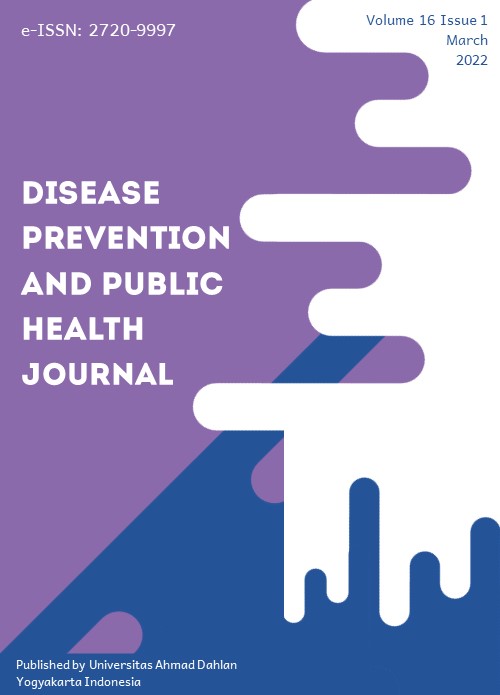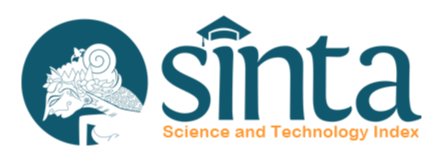Relationship of Appetite, Body Image, and Energy Intake with Body Mass Index in Undergraduate Students in Surakarta
DOI:
https://doi.org/10.12928/dpphj.v16i1.4044Keywords:
Appetite, Body image, Intake energy, BMIAbstract
Background: Young adults are vulnerable to lifestyle changes that will eventually change their behavior, including health behavior. Behavioral changes during this period can affect nutritional status. Nutritional status is affected by energy intake, influenced by several internal factors such as appetite and body image. This study shows the correlation between appetite, body image, and energy intake with body mass index. Method: This study was conducted with a random sampling method through 120 undergraduate students. Appetite was measured using a visual analog scale. Energy intake was measured using the 24-hour food recall method. Statistical analysis used was Spearman's rankBody shape perception was assessed using the Stunkard figure rating scale. Results: Appetite is closely related to energy intake (p <0.05) but not with BMI. Body image correlates with intake energy and BMI. Most obese students (70.4%) consider themselves overweight. Energy intake is correlated with BMI (p <0,001). Conclusion: Appetite and body image are related to food intake. Energy intake is correlated with body mass index.
References
2. Younossi, Z. M., Koenig, A. B., Abdelatif, D., Fazel, Y., Henry, L., & Wymer, M. (2016). Global Epidemiology of Nonalcoholic Fatty Liver Disease-Meta-Analytic Assessment of Prevalence, Incidence, and Outcomes. Hepatology (Baltimore, Md.), 64(1), 73–84. DOI: https://doi.org/10.1002/hep.28431
3. Lotrean LM, Stan O, Lencu C, Laza V. Dietary Patterns, Physical Activity, Body Mass Index, Weight-Related Behaviours and Their Interrelationship Among Romanian University Students-Trends From 2003 to 2016. Nutricion Hospitalaria. 2018;35(2):375–83. DOI: https://doi.org/10.20960/nh.1296
4. Peterson NE, Sirard JR, Kulbok PA, DeBoer MD, Erickson JM. Sedentary Behavior and Physical Activity of Young Adult University Students. Research in Nursing and Health. 2018;41(1):30–8. DOI: https://doi.org/10.1002/nur.21845
5. Vilaro MJ, Colby SE, Riggsbee K, Zhou W, Byrd-Bredbenner C, Olfert MD, et al. Food Choice Priorities Change Over Time and Predict Dietary Intake at the End of the First Year of College Among Students in the U.S. Nutrients. 2018;10(9):1–13. DOI: https://doi.org/10.3390/nu10091296
6. Porto-Arias JJ, Lorenzo T, Lamas A, Regal P, Cardelle-Cobas A, Cepeda A. Food Patterns and Nutritional Assessment in Galician University Students. Journal of Physiology and Biochemistry. 2018;74(1):119–26. DOI: https://doi.org/10.1007/s13105-017-0582-0
7. Breitenbach Z, Raposa B, Szabó Z, Polyák É, Szűcs Z, Kubányi J, et al. Examination of Hungarian College Students’ Eating Habits, Physical Activity and Body Composition. European Journal of Integrative Medicine. 2016;8:13–7. DOI: https://doi.org/10.1016/j.eujim.2016.11.007
8. Hassanzadazar H, Shokrekhoda A, Aminzare M. Nutritional Behavior of Female Students of School of Paramedical and Health in Zanjan. Journal of Human, Environment, and Health Promotion. 2017;2(4):245–52. DOI: https://doi.org/10.29252/jhehp.2.4.245
9. Mahan LK, Raymond JL. Food & The Nutrition Care Process. 14th ed. Canada: Elsevier; 2017. 709.
10. Romieu I, Dossus L, Barquera S, Blottière HM, Franks PW, Gunter M, et al. Energy Balance and Obesity: What are the Main Drivers? Cancer Causes and Control. 2017;28(3):247–58. DOI: https://doi.org/10.1007/s10552-017-0869-z
11. Stok FM, Renner B, Clarys P, Lien N, Lakerveld J, Deliens T. Understanding Eating Behavior During the Transition from Adolescence to Young Adulthood: A Literature Review and Perspective on Future Research Directions. Nutrients. 2018;10(6):1–16. DOI: https://doi.org/10.3390/nu10060667
12. Blundell JE. The Contribution of Behavioural Science to Nutrition: Appetite Control. Nutrition Bulletin. 2017;42(3):236–45. DOI: https://doi.org/10.1111/nbu.12279
13. Gibbons C, Hopkins M, Beaulieu K, Oustric P, Blundell JE. Issues in Measuring and Interpreting Human Appetite (Satiety/Satiation) and Its Contribution to Obesity. Current Obesity Reports. 2019 Jun;8(2):77–87. DOI: https://doi.org/10.1007/s13679-019-00340-6
14. Lee PC, Dixon JB. Food for Thought: Reward Mechanisms and Hedonic Overeating in Obesity. Current Obesity Reports. 2017;6(4):353–61. DOI: https://doi.org/10.1007/s13679-017-0280-9
15. Tomas-aragones L, Marron SE. Body Image and Body Dysmorphic Concerns. Acta Derm Venerol. 2016;(2):47–50. DOI: https://doi.org/10.2340/00015555-2368
16. Dewi RC, Wirjatmadi B. Energy Intake, Body Image, Physical Activity and Nutritional Status of Teenagers. Journal of Public Health in Africa. 2019;10(S1). DOI: https://doi.org/10.4081/jphia.2019.1194
17. Sai A, Othman MY, Wan Zaini WFZ, Tan CSY, Mohamad Norzilan NI, Tomojiri D, et al. Factors Affecting Body Image Perceptions of Female College Students in Urban Malaysia. Obesity Medicine. 2018;11:13–9. DOI: https://doi.org/10.1016/j.obmed.2018.06.004
18. Hendrickse J, Arpan LM, Clayton RB, Ridgway JL. Instagram and College Women’s Body Image: Investigating the Roles of Appearance-Related Comparisons and Intrasexual Competition. Computers in Human Behavior. 2017;74:92–100. DOI: https://doi.org/10.1016/j.chb.2017.04.027
19. Zarychta K, Chan CKY, Kruk M. Gender-Specific Body Areas Satisfaction and Body Weight Status in Adolescents: Mediating Effects of Physical Activity, Fruit and Vegetable Intake, and Energy-Dense Food Intake. Applied Psychology: Health and Well-Being. 2019;11(1):80–101. DOI: https://doi.org/10.1111/aphw.12145
20. Crooks B, Stamataki NS, Mclaughlin JT. Appetite, the Enteroendocrine System, Gastrointestinal Disease and Obesity. Proceedings of the Nutrition Society. 2020;(December 2019):1–9. DOI: https://doi.org/10.1017/s0029665120006965
21. Bergeron N, Al-saiegh S, Ip EJ. An Analysis of California Pharmacy and Medical Students’ Dietary and Lifestyle Practices. American Journal of Pharmaceutical Education. 2017;81(8):56–64. DOI: https://doi.org/10.5688/ajpe5956
22. Rahmawati T. Hubungan Asupan Zat Gizi dengan Status Gizi Mahasiswa Gizi Semester 3 Stikes PKU Muhammadiyah Surakarta. Profesi (Profesional Islam) : Media Publikasi Penelitian. 2017;14:49–57. DOI: https://doi.org/10.26576/profesi.148
23. Pratami TJ, Widajanti L, Aruben R. Hubungan Penerapan Prinsip Pedoman Gizi Seimbang Dengan Status Gizi Mahasiswa S1 Departemen Ilmu Gizi Fakultas Kesehatan Masyarakat Universitas Diponegoro Semarang. Jurnal Kesehatan Masyarakat. 2016;4:561–70. DOI: https://doi.org/10.33757/jik.v1i1.31
24. Layland EK, Exten C, Mallory AB, Williams ND, Fish JN. Suicide Attempt Rates and Associations with Discrimination Are Greatest in Early Adulthood for Sexual Minority Adults Across Diverse Racial and Ethnic Groups. LGBT Heal. 2020;7(8). DOI: https://doi.org/10.1089/lgbt.2020.0142
25. Fletcher JM, Ross SL. Estimating the Effects of Friends on Health Behaviors of Adolescents. Health Econ. 2018;27(10). DOI: https://doi.org/10.1002/hec.3780
26. Hannush MJ. Resilience: The Capacity for Resilience. Markers Psychosoc Matur. 2021;251–7. DOI: 10.1007/978-3-030-74315-4_16
27. Freire RH, Alvarez-Leite JI. Appetite Control: Hormones or Diet Strategies? Curr Opin Clin Nutr Metab Care. 2020;23(5):328–35. DOI: 10.1097/MCO.0000000000000675
28. Dorling J, Broom DR, Burns SF, Clayton DJ, Deighton K, James LJ, et al. Acute and Chronic Effects of Exercise on Appetite, Energy Intake, and Appetite-Related Hormones: The Modulating Effect of Adiposity, Sex, and Habitual Physical Activity. Nutrients. 2018;10(9). DOI: https://doi.org/10.3390/nu10091140
29. Stribiţcaia E, Evans CEL, Gibbons C, Blundell J, Sarkar A. Food texture influences on satiety: systematic review and meta-analysis. Sci Rep [Internet]. 2020;10(1):1–18. DOI: https://doi.org/10.1038/s41598-020-69504-y
30. Zanchi D, Depoorter A, Egloff L, Haller S, Mählmann L, Lang UE, et al. The impact of gut hormones on the neural circuit of appetite and satiety: A systematic review. Neurosci Biobehav Rev. 2017;80(February):457–75. DOI: https://doi.org/10.1016/j.neubiorev.2017.06.013
Downloads
Published
Issue
Section
License
Copyright (c) 2021 Universitas Ahmad Dahlan

This work is licensed under a Creative Commons Attribution-ShareAlike 4.0 International License.
Authors transfer the copyright and grant the Disease Prevention and Public Health Journal right of first publication with the work simultaneously licensed under a Creative Commons Attribution License (CC BY-SA 4.0) that allows others to share (copy and redistribute the material in any medium or format) and adapt (remix, transform, and build upon the material) the work for any purpose, even commercially with an acknowledgement of the work's authorship and initial publication in Disease Prevention and Public Health Journal. Authors are able to enter into separate, additional contractual arrangements for the non-exclusive distribution of the journal's published version of the work (e.g., post it to an institutional repository or publish it in a book), with an acknowledgement of its initial publication in Disease Prevention and Public Health Journal. Authors are permitted and encouraged to post their work online (e.g., in institutional repositories or on their website) prior to and during the submission process, as it can lead to productive exchanges, as well as earlier and greater citation of published work (See The Effect of Open Access).

This work is licensed under a Creative Commons Attribution-ShareAlike 4.0 International License.







